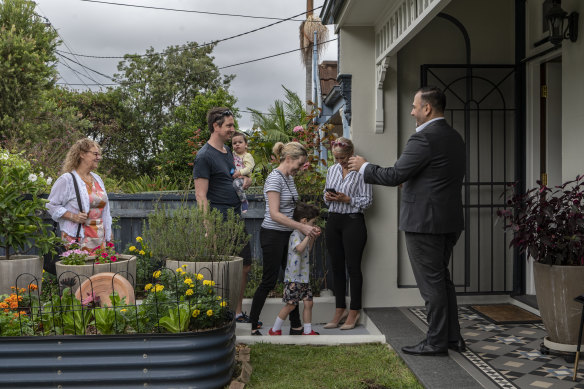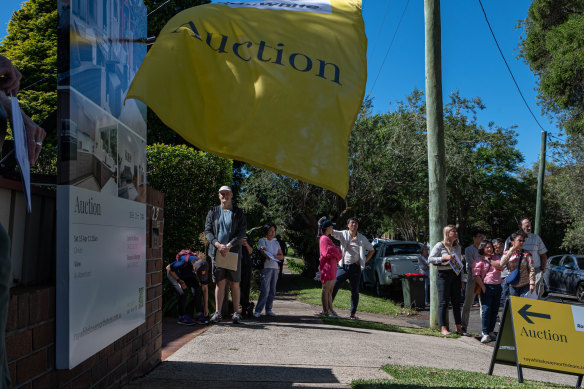This was published 2 years ago
Where are property prices forecast to head next?
By Kate Burke
Australia’s property market downturn could come to an end sooner than expected, experts say, as strong buyer demand and the limited supply of homes for sale curb price declines.
But clouds loom for the economy, and while the property downturn is likely to be milder than previously forecast, experts are divided on which way prices are headed next.

Property prices have started to rise but it may not last.Credit: Flavio Brancaleone
Home values nationally lifted 0.6 per cent last month, the first month-on-month rise since April 2022, CoreLogic figures show, leaving values 4.7 per cent below the market peak.
The increase had been attributed to a strong return in migration, a highly competitive rental market, a sharp drop in homes for sale and limited new building. But with the full impact of interest rate hikes still to come, and potential further rate rises, it could be short-lived.
NAB Group chief economist Alan Oster recently revised his outlook, reducing his peak-to-trough forecast from a fall of 20 per cent to 12 per cent, tipping house prices to drop about another 3.5 per cent and then flat line until the end of the year.
He has then tipped prices to rise 4.3 per cent in 2024, as the cash rate declines.

Interest rate rises have paused, but may begin again.Credit: Flavio Brancaleone
Interest rates looked to have peaked earlier than expected, Oster said, while stronger population growth, a tight rental market – pushing some renters into buying – and a strong labour market had offset the impact of rate rises on buyer borrowing power and demand.
“[However a challenge facing the market] is how consumers behave given rate increases are still flowing through, and a lot [of people] are rolling off fixed-loans onto significantly higher variable loans,” he said.
He added that any increase in the number of homes for sale, which has been well down as sellers hold back, could result in further price falls.
Barrenjoey chief economist Jo Masters has tipped prices to fall another 5.7 per cent this year, but has revised her peak-to-trough decline from 16 per cent to 12 per cent. In Sydney, the forecast decline has been revised from 22 per cent to 17 per cent.
She said the number of homeowners rolling off ultra-low fixed-rate mortgages onto higher variable rates had started to ramp up.
“April, May, June and July are the biggest roll off months [for fixed-rate mortgages] … it’s unquestionably going to be a material shock to those households,” she said, but added forced sales should be limited due to savings buffers and a strong jobs market.
However, further headwinds remain, she said.
“We haven’t called the low in the housing market, we think prices from here could bounce around sideways for a couple of months, but we still think there is more downside to come,” she said.
Masters said improvements in prices so far had typically been for higher priced Sydney properties, and did not expect a broad lift until 2024 when she tips a 2 per cent increase nationally due to interest rate cuts.
SQM Research managing director Louis Christopher has forecast prices nationally to lift 3 to 7 per cent if interest rates peak below 4 per cent. Sydney prices are tipped to climb between 5 and 9 per cent this year, and Melbourne between 1 and 5 per cent.
Buyer demand had increased from strong migration, first home buyer incentives and people returning from temporary lockdown-era sea and tree changes, at a time of fewer sellers.
“We have rising auction clearance rates, some data providers, ourselves included ... have been reporting a rise in prices, and we’ve been reporting a rise in vendor confidence with asking prices rising. It does appear as though the market has turned a corner,” he said.
However, Christopher noted that if rates were to rise again, the market would pause, then potentially decline.
AMP Capital chief economist Dr Shane Oliver expects price declines to continue until later this year, off the back of interest rate hikes and slower economic growth.
However, his forecast for a 15-20 per cent peak-to-trough decline may be too pessimistic, he said, given the rapid return of immigration, low rental vacancy rates and constrained supply.
The market may have passed its low point, he added, but this was unlikely given the fixed-rate mortgage cliff, slowing economy, reduced affordability – with borrowing power falling further than property prices – and the potential for further interest rate hikes.
“What we’re seeing now is somewhat unprecedented, in the past the market relied on lower interest rates to kick off a recovery,” he said.
“It’s still a highly risky environment and what we are seeing could be a dead cat bounce.”
Westpac senior economist Matthew Hassan said the bulk of the price correction had likely occurred, but expected more was to come.
“Correction cycles tend to come in two distinct phases. The first period is where rates are rising ... and you typically see the biggest price declines,” he said.
“The second phase is when rates are on hold, but still high and the impact of tightening is still rolling through the economy.”
Hassan noted recent price increases would be tested as more listings hit the market.
Rate cuts would be required for a market recovery to gain momentum, and he did not expect this until early 2024.